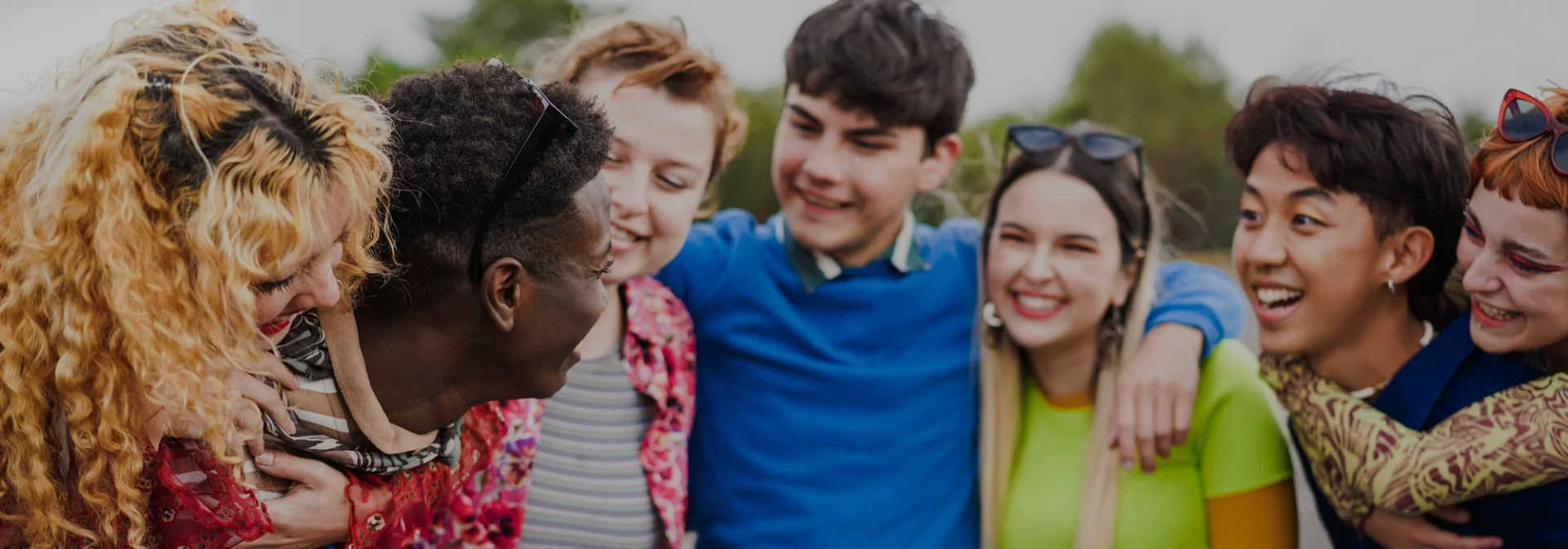Is my child LGBTQIA+? Here’s how to support them with gender, sexuality, and sexual orientation
Author Jen Bell | Reviewed by Mason Dunn
Gender and sexuality is deeply personal, and this spectrum might seem hard to define (and that’s okay). It’s not uncommon for many young people to feel confused or unsure about their gender or sexuality for a time, and it can be hard for them to open up and talk about their feelings, or even to find words for them.
It’s estimated that 4.5% of people in the U.S. are LGBTQ+ — that’s more than 14 million people! And, that’s not all, kids and teens who are neurodivergent can be more likely to also identify as LGBTQ+.
Neurodivergent individuals are 3-6 times more likely to also be LGBTQ+. Research currently shows that neurodivergent people, particularly those on the autism spectrum, are more likely to be gender diverse and have a lesbian, gay, bisexual, queer, or asexual sexual orientation, compared to neurotypical people. While research can not yet tell us definitively why, it may be because people who are neurodivergent may feel less pressure to fit into social pressures and expectations. Others may report even more fear of disclosing, due to concerns around potential discrimination and isolation.
Supporting Your Child With Their Gender Identity & Sexual Orientation
So, what can you do to support a LGBTQ+ child or teen? First, try not to make assumptions about who your young person is or who they are becoming — including their gender and sexuality, even if you feel they are “showing signs” or “dropping hints.”
Despite gender stereotypes, masculine and feminine traits do not necessarily predict whether someone is straight, gay, transgender, or cisgender.
Some young people may experiment with same-gender sexual experiences as they explore their own sexuality, but these experiences do not necessarily mean that a person is gay or bisexual. For many teens, these experiences are simply part of the process of sorting through their emerging sexuality. Scroll on to learn how to support your LGBTQ+ child, and get the intel that’ll help you navigate situations and conversations as they crop up with compassion, ease, and care.
How to Support LGBTQ+ Youth
In order to increase the comfort level of your young person to come out to you as LGBTQ+, you will need to create a loving and supportive environment where they feel safe to tell you. Here’s how:

Do Your Research
Get the facts about sexuality, gender, and the LGBTQIA+ community. Learn and use the correct terms for body parts and functions and think through your own feelings and values about gender, love, and sex.
A person’s sexual and romantic orientation is different from their gender identity. Put simply, your gender identity is about who you are, and your orientation is about who you are attracted to and fall in love with.
To learn more you can read through the BLOOM website, take a look at our recommended TV shows, films, and books, and reach out to support groups and organizations in your area.
LGBTQIA+ Film & TV
Film and television narratives can be like a mirror or a window for many LGBTQ+ young people. These stories can be a reflection on the experiences they are navigating in their daily life (like a mirror), or a window for new views and perspectives.
The Family Acceptance Project has created a series of powerful, short award-winning documentary films that show how ethnically and religiously diverse families learn to support and accept their lesbian, gay, bisexual and transgender children.
We’ve Been Around is a series of short films celebrating the lives of just a few transgender pioneers throughout history.
The Trans List is a 2016 documentary film by Timothy Greenfield-Sanders for HBO, which shines a light on eleven prominent transgender Americans.
The Netflix documentary Disclosure shines a spotlight on leading trans creatives and thinkers, and their perspectives and analysis about Hollywood’s impact on the trans community.
We also recommend PFLAG’s recommended viewing for parents of transgender youth.

LGBTQIA+ Support Groups
In order to thrive — as a teen or an adult — reliable support is essential. Beyond creating a safe and open container to explore ideas and feelings at home, support groups can offer safe haven and community connection for kids and teens with their peers. A support group is also a way your teen can support their friends and family as well.
Trans Families provides online support groups, resource directories, and educational resources for parents of transgender children
PFLAG is one of the oldest organizations in the US that supports the families, friends and allies of LGBTQ+ people. They have local chapters across the country, including groups specifically for families with transgender children.
The Trans Youth Equality Foundation provides education, advocacy and support for transgender and gender non-conforming children and youth and their families to help foster a healthy, caring, and safe environment for all transgender children.
Key things to know:
- A young person’s gender or sexuality is never “just a phase.” Embrace their evolving sense of self, don’t dismiss it!
- Being LGBTQIA+ is normal, healthy, and not something that needs to be fixed.
- It’s important to be available and open-minded if your young person wants to talk about gender or sexual orientation, but don’t try to force the issue.
Don’t worry about missing some information, just let your young person know when you don’t know, and offer to find the answer together.
Let Your Values About LGBTQIA+ People Be Known
Sharing feelings and shedding light on your values can help foster productive and open-ended conversations between you and your child. While modeling your own feelings and perspectives is important, it’s also vital to make these conversations a two-way street. Make sure to let your teen know that you’re ready and able to listen to a young adult about their feelings and observations.
- Support your young person’s diverse friendships and social involvement without focusing on expectations around gender.
- Let them know it’s safe to explore and play with gender in a way that feels comfortable to them. Don’t put pressure on them to figure out what their gender identity is.
- Use gender-neutral terms when talking about potential girlfriends or boyfriends: “Is there anyone at school you like?”
- Expose your young person to diverse books, TV shows, and movies involving LGBTQIA+ characters, especially if they don’t have many of these examples in their day-to-day life. Discuss the characters and the topics that come up. Show support for LGBTQIA+ causes and for LGBTQIA+ people on TV or in the media.
- Talk about families that are different from yours. Provide your young person with exposure to people working and enjoying activities outside of conventional gender expectations. If you know LGBTQIA+ individuals or couples, invite them over so your young person can get to know them too.
- Advocate for safe spaces where your young person can explore interests without judgment or stereotypes. Avoid using slurs or telling anti-LGBTQIA+ jokes, and never let hateful or prejudiced comments go unanswered.

Encourage Dialogue
Healthy dialogue is a central player in cultivating a supportive environment with your child. Talk with your young person. Listen more than you speak. Only by listening to each other can you understand one another, especially regarding love and sexuality.
Research shows that young people’s preferred source of information about sex, relationships, and sexual health is in fact their caregivers.
When young people are able to talk with a caregiver or other significant adult about sex and protection, they are less likely to engage in early and/or unprotected sexual intercourse compared to young people who haven’t talked with a trusted adult.
For caregivers who find that talking about sex does not come naturally, it may be necessary to learn new skills in order to create open lines of communication.
Stay involved in the details of your young person’s life. Engage in conversations and check regularly with them about their interests, friend groups, romantic attractions, and any bullying or teasing that may be taking place.
Don’t avoid any topics that make you feel uncomfortable — your young person will pick up on this. When you avoid certain topics, you send a message that you may not be accepting of these things.

Be Patient
Conversations around identity — especially sexuality, gender, and orientation — can be overwhelming or just hard to articulate out loud. Which means, being patient will help alleviate pressure your child may feel around defining themselves, coming out, or just exploring ideas and concepts.
If you think your young person might be LGBTQ+ don’t ask them directly or try to trick them into revealing this information. Young people need time to work things out, to learn, and to accept who they are.
They may feel a lot of pressure to decide whether they are transgender, cisgender, gay, straight, or bisexual, when in reality gender and sexuality are fluid and can change over time. Once aware, some gay young people may be quite comfortable and accept their identity, while others might find it confusing or difficult to accept.
Coming out can come with huge fears of rejection, so young people usually come out to the person they feel is safest. This is why creating a loving and supportive environment is key. Trust your young person, they will tell you when they are ready.
Let Them Know They Are Loved
Always lead with love and compassion — this creates a healthy and safe environment in which your child feels safe and supported to bring up concerns, life achievements, or just sharing new aspects of their identity with you.
Saying something like, “I’m here for you, I love you, and I support you,” can mean the world to a young person who just wants to be accepted.
Research shows that LGBTQIA+ adolescents who are supported by their families grow up to be happier and healthier adults. You don’t need to be an expert in all things LGBTQIA+ to show them that you care. Just be present and open. Saying something like, “I’m here for you, I love you, and I support you,” can mean the world to a young person who just wants to be accepted.
